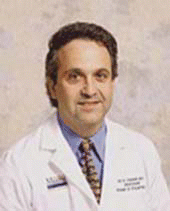For diseases such as chronic sinusitis that is unresponsive to treatment, allergic fungal sinusitis (AFS), cystic fibrosis (CF), and nasal polyps, Dr. Casiano said, “I will try to address the questions that keep lingering.” These questions surround issues like the timing and degree of surgery after medical therapy, the role for “small-hole” surgery or balloon sinuplasty in these patients, the necessity of computer navigation, and when advanced or extended procedures are called for.
Explore This Issue
August 2006Addressing the timing and degree of surgery, Dr. Casiano said that surgery can improve certain symptoms, including nasal obstruction, headaches, and infection. Surgery may be indicated when the endoscopic follow-up correlates well with the CT scan, but not the symptoms—and some systemic disease may expedite the need for surgery.
Since chronic sinusitis is an inflammatory, perhaps systemic disorder, the use of anti-inflammatory medication plays an important treatment role prior to surgery.
Dr. Casiano stressed that for patients with advanced disease, “Patient expectations have to be really clear. Before you operate, they have to understand what they’re going to gain, and understand that they have an ongoing disease.” He warned that a certain percent of these patients won’t see any improvement in their symptoms, despite the best surgery and medical therapy.
Role of New Technologies
As for small-hole surgery or balloon sinuplasty, Dr. Casiano said, “Obviously, this is very new technology, and there is no current evidence for balloon procedures in hyperplastic disease. Therefore, there’s no comparison to established techniques.” He added that these new techniques are highly unlikely to be effective in AFS, CF, or other chronic hyperplastic conditions, especially where dependent sinuses necessitate removal of thick tenacious secretions or soft tissue. However, they may be effective in addressing limited ostiomeatal complex polyps with limited to no mucosal disease of the dependent sinuses.
“[Computer navigation is] a great teaching tool, but it should not be necessary to determine the location of the maxillary, ethmoid, and sphenoid sinus in an otherwise uncomplicated sinus case.” – —Roy R. Casiano, MD
Dr. Casiano then pondered the question, Is computer navigation necessary? “It’s a great teaching tool, but it should not be necessary to determine the location of the maxillary, ethmoid, and sphenoid sinus in an otherwise uncomplicated sinus case.” Its use should be determined by the experience of the surgeon, he concluded.
Finally, Dr. Casiano addressed the question of when advanced procedures of the frontal, maxillary, and sphenoid sinuses are indicated. “There are four main indicators,” he said. “Osteoneogenesis and outflow narrowing in previously operated cases, with persistent disease, is the first.” The next is a procedure that can facilitate the approach into difficult-to-access air cells or anatomical areas, including the supraorbital, clival, rostrum, inferior or lateral maxillary, or petrous apex. An otolaryngologist–head and neck surgeon may also need access for oncologic margins; finally, complication of chronic or acute rhinosinusitis is an indicator.
Focus on Good Medicine, Patient Care
Dr. Casiano concluded by urging physicians to look at safety considerations, cost-effectiveness, and patient expectations of results when they consider the above indications for surgery.

Leave a Reply